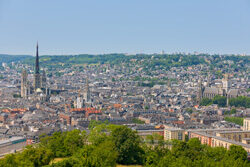
Important in the Roman era and Middle Ages, it has Gothic churches, such as Saint-Maclou and Saint-Ouen, and a cobblestoned pedestrian center with medieval half-timbered houses. The skyline is dominated by the spires of Cathédrale Notre-Dame, much-painted by Impressionist Claude Monet.
After the first Viking incursion into the lower valley of the Seine in 841, they went on to overrun Rouen, and some of them settled and founded a colony led by Rollo (Hrolfr), who was nominated to be count of Rouen by King Charles in 911. In the 10th century Rouen became the capital of the Duchy of Normandy and the residence of the dukes, until William the Conqueror established his castle at Caen.
The city center is compact and all sights can easily be seen by foot. There are city buses as well as a light rail line which heads north to south. Velo-R north of the Seine on Avenue Jeanne D’ Arc (near the metro station) rents bikes for 1-2 Euro per day. The city also has an official bicycle rental scheme where you can rent a bike at one location and drop it off at another.
Rouen is known for its Notre Dame cathedral, with its Tour de Beurre (butter tower) financed by the sale of indulgences for the consumption of butter during Lent. The cathedral’s gothic façade was the subject of a series of paintings by Claude Monet, some of which are exhibited in the Musée d’Orsay in Paris. Other famous structures include Rouen Castle, whose keep is known as the tour Jeanne d’Arc, where Joan of Arc was brought in 1431 to be threatened with torture.
Notre Dame Cathedral, exceptionally complex church is renowned for the juxtaposition of all the periods of Gothic, especially on the facade, which the artist Monet painted time and again, reflecting its glory in different lights. The interior is packed with religious and artistic points of interest. The archbishop’s palace and further Gothic buildings attached to the cathedral have also survived, adding to the fascination of this historic quarter.
Saint Joan of Arc, byname the Maid of Orléans, French Sainte Jeanne d’Arc or La Pucelle d’Orléans, national heroine of France, a peasant girl who, believing that she was acting under divine guidance, led the French army in a momentous victory at Orléans that repulsed an English attempt to conquer France during the Hundred Years’ War. Captured a year afterward, Joan was burned to death by the English and their French collaborators as a heretic. She became the greatest national heroine of her compatriots, and her achievement was a decisive factor in the later awakening of French national consciousness.